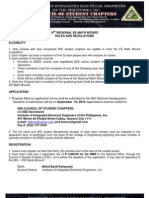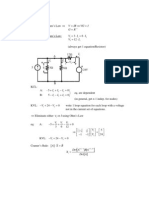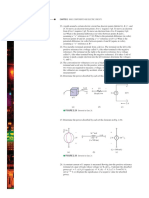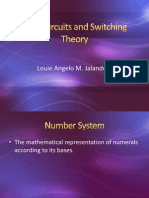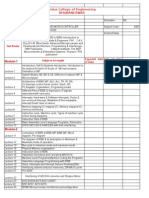Problem Sheet Module 1
Uploaded by
Mohan B SomashakarProblem Sheet Module 1
Uploaded by
Mohan B SomashakarBasic Electrical Engineering EEE15/25
MODULE - I
POTENTIAL THEORY QUESTIONS
1. Explain Ohm’s law and its limitations.
2. Describe the change in value of resistance as temperature changes.
3. Write a note on Kirchhoff’s laws.
4. Explain the heating effect of electric current.
5. Explain charge, voltage, current and power.
6. Explain resistance, specific resistance and conductivity.
7. Prove that sum of voltages is a closed loop is always zero.
8. Prove that sum of currents at any node or junction is always zero.
9. Questions on resistance color coding.
10. State and prove Superposition theorem.
11. State and prove Thevenin’s theorem.
12. State and prove Norton’s theorem.
13. State and prove Maximum power transfer theorem.
POTENTIAL PROBLEMS
I - Problems to solve for R equivalent
1. Solve for equivalent resistance between AB for the circuits shown below from fig.1 to 11
(Hint: only series/parallel)
Fig.2 Fig.3
Fig.1
Fig.4
Fig.5
Fig.6 Fig.7 Fig.8
Department of Electrical & Electronics Engineering
NHCE
Basic Electrical Engineering EEE15/25
Fig.9
Fig.10
Fig.11
2. Solve for Resistance between AC, CD, DB, AD and AB for circuit shown in fig,12 to 14
Fig.12 Fig.13 Fig.14
Department of Electrical & Electronics Engineering
NHCE
Basic Electrical Engineering EEE15/25
3. Solve for Resistance between, 1)A and B, (2) C & D, (3) E & F, (4) A & F, (5) A & C. Number represent resistance
in ohms for the circuit shown in fig.15
Fig.15
4. One branch of an electric circuit consists of two
resistances 2Ω & 4Ω connected in parallel. Another
branch consists of three resistances 1Ω, 3Ω &
5Ω connected in parallel. These two branches are connected in series. A resistance of 7Ω is connected
in parallel with this combination. Find the total
equivalent resistance across this combinational circuit.
If a 10V battery with an internal resistance of 0.2Ω is
connected across the circuit. Find 1) the total current 2)
current through 4Ω, 3) Power consumed in 5Ω.
II Problems to find R based on other parameters
5. Two resistors R1 and R2 are connected in parallel. The voltage
applied is 220V. The current taken is 30A. The power dissipated in one of the resistance is 1600W.
Find the value of the two resistances R1 and R2.
6. A resistance of 5Ω is connected in series with a parallel
combination of RΩ and 10Ω. The total power consumed by the
circuit is 1200W. The applied voltage is 100V. Find R.
7. The total power consumed by the network shown in fig.16 is
16W. Find the value of R and total current.
Fig.16
8. In the circuit shown in fig.17, the voltage across 8Ω is 12V
having polarities as shown. Find the value of R.
Fig.17
9. Determine the value of resistance R, if the power dissipated in 10Ω resistance is 360W in the circuit
shown in fig.18.
Department of Electrical & Electronics Engineering
NHCE
Basic Electrical Engineering EEE15/25
Fig.18
10. A resistance of 10Ω is connected in series with a combination of two resistance arranged in parallel,
each of 20Ω. Calculate the value of resistance which should be shunted across the parallel
combination so that the total current drawn by the circuit is 1.5A with applied voltage of 20V, also
calculate the value of resistance which should be shunted across the supply so that the total current
drawn from first case remains same for the 20V supply.
11. A resistance of R is connected in series with a parallel circuit consisting of 15Ω & 10Ω resistance.
When a voltage of 20V is applied across the circuit,
a total power of 40W is dissipated. Find R
12. A 20V battery with internal resistance of 5Ω is
connected to a resistance of RΩ. If an additional 6Ω
resistance is connected across battery, find the value
of R so that the power supplied externally by the battery
remains same.
III Problems based on Current & Voltage divider
13. The current in 6Ω resistor for the circuit shown in fig.19 is 2A. Find currents in all other resistors and
voltage across the network.
Fig.19
14. For the circuit shown in fig.20, find equivalent resistance between points A&B, the current supplied by
battery and current flowing through all resistors.
Fig.20
Fig.21
15. An 8Ω resistor is in series with a parallel combination of two resistors 12Ω & 6Ω. If the current in 6Ω
is 5A, determine the current in 12 & 8 ohms resistors, voltage applied for the circuit and total power
dissipated in the circuit.
Department of Electrical & Electronics Engineering
NHCE
Basic Electrical Engineering EEE15/25
16. Determine I, I1, I2, Vab, Vbc in the circuit shown in fig.21. (Hint: Use both method)
- +
+ -
+
-
+
-
Fig.22 Fig.23
17. In the circuit shown in fig.22 find a) current in all branches, b) then voltage across 18Ω, c) verify the
voltage across 18Ω using voltage divider method.
IV Problems based on Mesh current analysis/KVL
18. For the circuit shown in fig.21 apply mesh current analysis to find I, I1, I2, Vab, Vbc.
19. Find the current in all the resistors and voltage drops according to the polarity marked for the circuit
shown in fig.23.
20. Apply mesh analysis and determine the currents I1, I2 & I3 in the circuit shown in fig.24a & 24b also
find unknowns Ix, Vx, Iy & Vy
+Vx - Iy
+ Vy -
Ix
Fig.24a Fig.24b
Fig.25a Fig.25b
21. Obtain the potential difference VXY in the circuit shown in fig.25a & 25b.
Department of Electrical & Electronics Engineering
Fig.27
Fig.26
NHCE
Basic Electrical Engineering EEE15/25
22. Find the values of the variables indicated in the circuit of fig.26. All the resistances are in ohms.
23. Compute the value of battery current I and voltage drop across 6kΩ of fig.27 when switch S is a)
closed, b) open. All resistor values in ohms.
V Problems based on Node voltage analysis/KCL
24. For the circuit shown in fig.20 find the current supplied by battery and all branch currents.
25. For the circuit shown in fig.23 find all branch currents and voltage drops across each passive elements.
26. For the circuit shown in fig.24a find mesh currents.
27. For the circuit shown in figure 28, find I1 and V1, given R3 =6Ω
Fig.28
Department of Electrical & Electronics Engineering
NHCE
You might also like
- Circuit 2: Admittance: I. Applying Complex Numbers To Parallel Ac CircuitsNo ratings yetCircuit 2: Admittance: I. Applying Complex Numbers To Parallel Ac Circuits22 pages
- Logic Circuits and Switching Theory: By: John Neil F. RomasantaNo ratings yetLogic Circuits and Switching Theory: By: John Neil F. Romasanta59 pages
- Final Requirement IN EE320A/L: (Basic Electrical Engineering)No ratings yetFinal Requirement IN EE320A/L: (Basic Electrical Engineering)25 pages
- 04 Temperature Resistance Effects Part 2 PDF100% (1)04 Temperature Resistance Effects Part 2 PDF7 pages
- Sinusoidal Voltage and Current: Engr. Gerard Ang School of EECENo ratings yetSinusoidal Voltage and Current: Engr. Gerard Ang School of EECE28 pages
- Nodal Analysis Mesh Analysis Superposition Thevenin's and Norton TheoremNo ratings yetNodal Analysis Mesh Analysis Superposition Thevenin's and Norton Theorem132 pages
- Reviewer Electrical Circuits 1 Eea Exam 2No ratings yetReviewer Electrical Circuits 1 Eea Exam 217 pages
- CMO 24 s2008 Annex III Course Specification For The BSECENo ratings yetCMO 24 s2008 Annex III Course Specification For The BSECE37 pages
- Physics 121 Practice Problem Solutions 11 Faraday's Law of InductionNo ratings yetPhysics 121 Practice Problem Solutions 11 Faraday's Law of Induction13 pages
- MCQ in Computer Fundamentals Part 2 ECE Board ExamNo ratings yetMCQ in Computer Fundamentals Part 2 ECE Board Exam19 pages
- Simple Resistive Circuits: Assessment ProblemsNo ratings yetSimple Resistive Circuits: Assessment Problems50 pages
- Module 4 - Series Circuit Resistance and InductanceNo ratings yetModule 4 - Series Circuit Resistance and Inductance10 pages
- Lab Activity 2: Verification of Voltage and Current Division TheoremsNo ratings yetLab Activity 2: Verification of Voltage and Current Division Theorems5 pages
- Application of ODEs - Series RL CircuitNo ratings yetApplication of ODEs - Series RL Circuit12 pages
- 50 TOP PARALLEL CIRCUITS Questions and Answers PDFNo ratings yet50 TOP PARALLEL CIRCUITS Questions and Answers PDF5 pages
- Determine The Maximum Number of Electrons That Can Exist in The Third Shell of An Atom100% (1)Determine The Maximum Number of Electrons That Can Exist in The Third Shell of An Atom3 pages
- Problem Set B Sinusoids and Phasors: John Alfred A. Ceniza BSME-5No ratings yetProblem Set B Sinusoids and Phasors: John Alfred A. Ceniza BSME-55 pages
- Basic Electrical Engineering Question Bank-21EEE15ANo ratings yetBasic Electrical Engineering Question Bank-21EEE15A18 pages
- Easy(er) Electrical Principles for General Class Ham License (2019-2023)From EverandEasy(er) Electrical Principles for General Class Ham License (2019-2023)No ratings yet
- New Horizon College of Engineering, Bangalore CIE Test (Even Semester AY: 2016-17)No ratings yetNew Horizon College of Engineering, Bangalore CIE Test (Even Semester AY: 2016-17)1 page
- Electrical Engineering Job Interview Preparation GuideNo ratings yetElectrical Engineering Job Interview Preparation Guide22 pages
- Samsung SR255MLS User and Installation Guide - OptimizedNo ratings yetSamsung SR255MLS User and Installation Guide - Optimized28 pages
- Service Manual: EPSON STYLUS CX3500/CX3650/CX3600/ CX4500/CX4600No ratings yetService Manual: EPSON STYLUS CX3500/CX3650/CX3600/ CX4500/CX4600206 pages
- Smart Water Vending Machine: Power Supply LCD Display (16 X 2 LINES) SolenoidNo ratings yetSmart Water Vending Machine: Power Supply LCD Display (16 X 2 LINES) Solenoid3 pages
- Design and Modelling of An Automatic 3-Point Starter of A Shunt DC MotorNo ratings yetDesign and Modelling of An Automatic 3-Point Starter of A Shunt DC Motor5 pages
- IoT Modules For LPWA, 4G, 3G, and 2G Networks - Sierra WirelessNo ratings yetIoT Modules For LPWA, 4G, 3G, and 2G Networks - Sierra Wireless8 pages
- Software Requirements Specification: Exam EarnNo ratings yetSoftware Requirements Specification: Exam Earn22 pages
- Standalone Metal Rfid Series Installation and User Guidev1.0 - ZK - 20171122No ratings yetStandalone Metal Rfid Series Installation and User Guidev1.0 - ZK - 2017112218 pages
- List of Experiments: Ge8261-Engineering Practices Laboratory - Group BNo ratings yetList of Experiments: Ge8261-Engineering Practices Laboratory - Group B57 pages
- Circuit 2: Admittance: I. Applying Complex Numbers To Parallel Ac CircuitsCircuit 2: Admittance: I. Applying Complex Numbers To Parallel Ac Circuits
- Logic Circuits and Switching Theory: By: John Neil F. RomasantaLogic Circuits and Switching Theory: By: John Neil F. Romasanta
- Final Requirement IN EE320A/L: (Basic Electrical Engineering)Final Requirement IN EE320A/L: (Basic Electrical Engineering)
- Sinusoidal Voltage and Current: Engr. Gerard Ang School of EECESinusoidal Voltage and Current: Engr. Gerard Ang School of EECE
- Nodal Analysis Mesh Analysis Superposition Thevenin's and Norton TheoremNodal Analysis Mesh Analysis Superposition Thevenin's and Norton Theorem
- CMO 24 s2008 Annex III Course Specification For The BSECECMO 24 s2008 Annex III Course Specification For The BSECE
- Physics 121 Practice Problem Solutions 11 Faraday's Law of InductionPhysics 121 Practice Problem Solutions 11 Faraday's Law of Induction
- MCQ in Computer Fundamentals Part 2 ECE Board ExamMCQ in Computer Fundamentals Part 2 ECE Board Exam
- Module 4 - Series Circuit Resistance and InductanceModule 4 - Series Circuit Resistance and Inductance
- Lab Activity 2: Verification of Voltage and Current Division TheoremsLab Activity 2: Verification of Voltage and Current Division Theorems
- 50 TOP PARALLEL CIRCUITS Questions and Answers PDF50 TOP PARALLEL CIRCUITS Questions and Answers PDF
- Determine The Maximum Number of Electrons That Can Exist in The Third Shell of An AtomDetermine The Maximum Number of Electrons That Can Exist in The Third Shell of An Atom
- Problem Set B Sinusoids and Phasors: John Alfred A. Ceniza BSME-5Problem Set B Sinusoids and Phasors: John Alfred A. Ceniza BSME-5
- Basic Electrical Engineering Question Bank-21EEE15ABasic Electrical Engineering Question Bank-21EEE15A
- Easy(er) Electrical Principles for General Class Ham License (2019-2023)From EverandEasy(er) Electrical Principles for General Class Ham License (2019-2023)
- New Horizon College of Engineering, Bangalore CIE Test (Even Semester AY: 2016-17)New Horizon College of Engineering, Bangalore CIE Test (Even Semester AY: 2016-17)
- Electrical Engineering Job Interview Preparation GuideElectrical Engineering Job Interview Preparation Guide
- Samsung SR255MLS User and Installation Guide - OptimizedSamsung SR255MLS User and Installation Guide - Optimized
- Service Manual: EPSON STYLUS CX3500/CX3650/CX3600/ CX4500/CX4600Service Manual: EPSON STYLUS CX3500/CX3650/CX3600/ CX4500/CX4600
- Smart Water Vending Machine: Power Supply LCD Display (16 X 2 LINES) SolenoidSmart Water Vending Machine: Power Supply LCD Display (16 X 2 LINES) Solenoid
- Design and Modelling of An Automatic 3-Point Starter of A Shunt DC MotorDesign and Modelling of An Automatic 3-Point Starter of A Shunt DC Motor
- IoT Modules For LPWA, 4G, 3G, and 2G Networks - Sierra WirelessIoT Modules For LPWA, 4G, 3G, and 2G Networks - Sierra Wireless
- Standalone Metal Rfid Series Installation and User Guidev1.0 - ZK - 20171122Standalone Metal Rfid Series Installation and User Guidev1.0 - ZK - 20171122
- List of Experiments: Ge8261-Engineering Practices Laboratory - Group BList of Experiments: Ge8261-Engineering Practices Laboratory - Group B



















